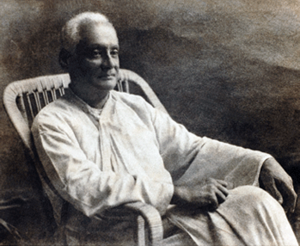Gaganendranath Tagore facts for kids
Quick facts for kids
Gaganendranath Tagore
|
|
|---|---|
 |
|
| Born | 17 September 1867 |
| Died | 14 February 1938 (aged 70) Calcutta, Bengal Presidency, British India
|
| Nationality | Indian |
| Known for |
|
| Movement | Bengal School of Art |
Gaganendranath Tagore (born September 17, 1867 – died February 14, 1938) was a talented Indian painter and cartoonist. He was a key artist in the Bengal School of Art. Many people consider him and his brother, Abanindranath Tagore, to be among the first modern artists in India.
Contents
Life and Art Journey
Gaganendranath Tagore was born in Jorasanko, a place in Calcutta. His family was very creative and important to Bengal's culture. He was the oldest son of Gunendranath Tagore. His great-grandfather was Prince Dwarkanath Tagore. His brother, Abanindranath, was a leader in the Bengal School of Art. Gaganendranath was also the nephew of the famous poet Rabindranath Tagore. He was the great-grandfather of actress Sharmila Tagore.
Early Training and Influences
Gaganendranath did not go to a formal art school. Instead, he learned from a watercolour artist named Harinarayan Bandopadhyay. In 1907, he and his brother Abanindranath started the Indian Society of Oriental Art. This group later published an important art magazine called Rupam.
Between 1906 and 1910, Gaganendranath learned Japanese brush techniques. He also studied art from East Asian countries. You can see this influence in his drawings for Rabindranath Tagore's book, Jeevansmriti (1912). He then created his own unique style in his Chaitanya and Pilgrim art series.
Moving Towards Modern Art
Gaganendranath later moved away from the traditional style of the Bengal School. He started drawing caricatures, which are funny drawings that exaggerate people's features. The Modern Review magazine published many of his cartoons in 1917. From 1917 onwards, his funny drawings were also put into books. Some of these books were Play of Opposites, Realm of the Absurd, and Reform Screams.
Between 1920 and 1925, Gaganendranath was a pioneer in modern painting. He experimented with new styles. Art expert Partha Mitter said that Gaganendranath was the only Indian painter before the 1940s who used the style of Cubism in his art. Cubism is an art style where objects are broken up and painted from different angles. After 1925, he developed an even more complex style that built on Cubism.
Other Interests
Gaganendranath was also very interested in theatre. He even wrote a children's book called Bhodor Bahadur, which means 'Otter the Great'. It was written in a similar style to the famous author Lewis Carroll.
Artworks and Books
- Adbhut Lok: realm of the absurd, 1917: This book was a collection of thirteen funny and satirical pictures.
- Naba Hullod: Reform screams; a pictorial review at the close of the year 1921, 1921: This book also featured satirical drawings.
- Birupa bajra (Play of Opposites), 1930: Another collection of his unique and often humorous art.
- Bhondor bahadur, 1998: A classic children's book he wrote.
Gallery
-
"In this patch of light the maids have gathered,... rolling cotton waste into lamp-wicks, and chatting in undertones of their village homes", illustration in Rabindranath Tagore's Jivan Smriti (জীবন-স্মৃতি, My Reminiscences), 1912
-
Sat-Bhai Champa. Watercolour, 34 × 25 cm, Victoria Memorial, Kolkata
Images for kids
See also
- Tagore family






